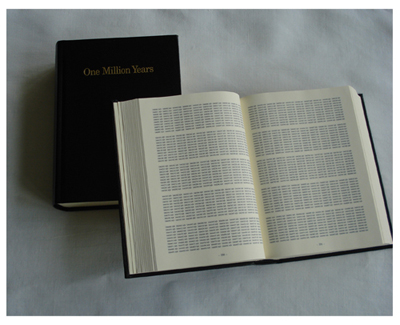|
On Kawara One Milion Years, 1999 |
| Object | Artist’s book | 2 volumes |
| 2012 pag. each | 14.4 x 10.5 cm (x2) |
 |
| The One Million Years project consists of two parts: One Million Years – Past and One Million Years – Future. The first part, Past, was conceived earlier. Its first version was executed in a typescript in 1970-71. It comprised 10 notebooks and covered the period since 998,031 B.C. until 1969 A.D. The artist was consecutively typing year after year – 500 years per page, ordered in 10 regular columns. Each volume contained 100,000 years on 200 pages, collected in transparent plastic envelopes (2 sheets of paper in one envelope). In 1980, the future was counted similarly since 1980 onwards. In 1993, the artist presented his project in the Dia Art Foundation in New York. Then he provided his notebooks with a motto: “For all those who lived and died” (Past) and “For the last one” (Future). Later, the books were also presented as a recording, in which a male and a female voice was continuously counting year upon year. The artist himself produced 12 editions of One Million Years – Past and subsequent editions of One Million Years – Future were still in progress after 2000. The beginning and concluding dates of One Million Years – Future vary according to the year in which Kawara began to work on the particular edition. In 1999, a printed version was published by Editions Micheline Szwajcer & Michèle Didier with the same dates as the exhibits presented in the Dia Foundation. The first volume starts in 998,031 B.C. and ends in 1969 A.D. The second volume starts in 1993 A.D. and ends one million years later, in 1,001,992. The edition is limited to 570 copies: 500 numbered copies, ranging from 061 to 560; 60 signed copies, ranging from 01/60 to 60/60 and 10 AP ranging from 561 to 570. As one critic brilliantly observed (René Denizot, 1979), the history of human civilization comprises only 10 last pages out of the 2000 included in One Million Years – Past. On Kawara’s project seems to overcome the unresolved difficulties with accessing unreachable past and future simply by means of naming (speaking out) the numbers of the years. In doing so, Kawara produces the illusion of remaining in control over vast quantities of time. To realize the meaning of his project means to prolong one’s presence one million years in the past and in the future. Dorota Monkiewicz |

